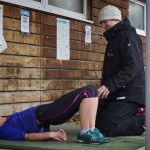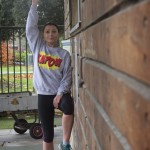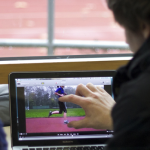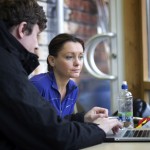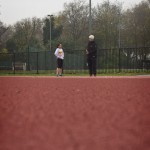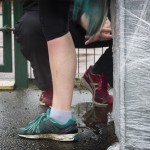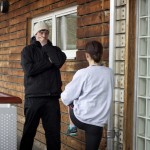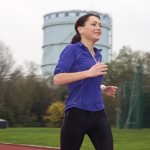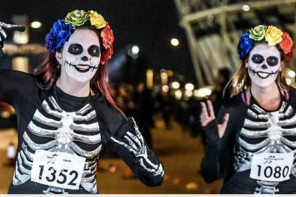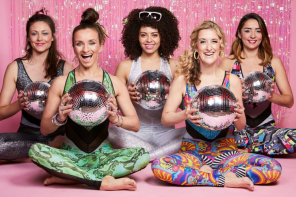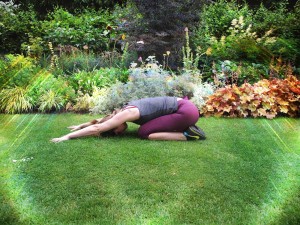This man can make you run faster, lighter and with less effort. This man can help you overcome injury and reduce the likelihood of it happening again. This man is not Santa.
A couple of weeks ago on a dull and drizzly Saturday morning I dragged myself out of bed and headed down to Battersea track to meet James Dunne from Kinetic Revolution, running and triathlon training specialists. The plan was to analyse my running form and get some tips, drills and exercises to help me run better, faster, with less injuries and less effort. Sounds amazing huh? So good in fact, that I didn’t really buy it.
I’d been to a form coaching session before, albeit a free group one, and found the advice generic and one size fits all. Everyone trying to run in exactly the same way didn’t really work for me. It seemed to make more sense to work with your own natural style. As such, I must admit to being a bit of a sceptic. Then Lorna, one of our readers, sent an email extolling the virtues of Kinetic Revolution and how a session with James had helped her deal with on-going knee problems and achieve a new 10k PB. I checked out the website. These guys train everyone from beginners to elite athletes. I then discovered we had a couple of mutual friends in common, both of whom work in the running industry and know their stuff. I figured there’s got to be something in this. I went along. I am a total convert.
How it works
http://www.kinetic-revolution.com/
Individual sessions last for two hours and involve video analysis and technique coaching.
After meeting Running Coach and Rehabilitation Specialist James, who incidentally is lovely, we had a quick chat about my running and injury history (not much for a while luckily), training and anything specific I was looking to get out of the session (make marathon training a breeze and ace the VLM).
Then it was time to get on the track. A couple of laps warm up while James set up the camera then some filmed slow laps, some fast ones and more slow ones to see how my form changed when fatigued and at different speeds. I had to tuck my top into my tights so that the video could capture how everything was working in that area, looked like a numpty.
Then we watched the video back. Fascinating. You never really see yourself run except for the odd glimpse in shop windows. It’s a very strange experience. James picked out some good points (just to make me feel better I think) then it was on to the areas for improvement. So basically I run with swaying hips, sashaying arms and tiny mincing steps. I run like I’m on a catwalk, which wastes energy and isn’t particularly efficient. I heel strike (landing heel first) and while I have a fast cadence (foot turnover) the reason I don’t run faster is because my stride is so short. Want a laugh? Here’s the video. WARNING this footage includes slow-mo close-up of my ass. Not for the fainthearted.
Kinetic Revolution Running Video Analysis
After we’d picked my running to pieces – in a very constructive way obv – we went outside for some drills and techniques to help improve form. One thing that really gave me confidence in James at this stage was his comment that ‘not all heel strikes are created equal’. A man of science not bandwagons, like it. It seems to be fashionable at the moment to be down on heel strikes but while the jarring foot out in front type can cause issues, there are lots of others that are not really a problem – in fact a large proportion of top distance runners heel strike so I’m in good company.
Drills are obviously tailored to the individual. Mine including, among others, running with feet kicking up at the back (toes flexed rather than pointed) to lengthen stride and driving my arms backwards to propel me forwards and prevent the wasted energy my swingy arms were causing. We alternated between performing the drills in an exaggerated manner, then normal running style, then the drill but less exaggerated. Honestly, it’s like someone took the brakes off. As soon as you start running the way James suggests, when you go back to your own technique you can feel physically how you’re sabotaging yourself with your form. Fab.
There are also a couple of quick tests to monitor your mobility and James then runs through a number of running-specific strengthening exercises to target areas where you need to build power. Inner butt muscles for me. Didn’t know you could do exercises for these but you can. And they hurt. (Check out their running strength workouts of the day here).
Now I’m not going to pretend I came away and was suddenly running light as a fairy and fast as Mo. I didn’t. But this is just the first step in becoming a better runner. Follow the techniques and training drills for a few months and you should definitely see an improvement. Like all things worth doing it takes time, effort and patience to get results. I’m going to book in for a six-month follow-up session and this time I want a gold star. All in all a very good investment.
To find out more about running technique and conditioning or to book a session visit http://www.kinetic-revolution.com. They’ve also got loads of great articles about running form and some free strength exercises on their website too so it’s well worth having a look.
Images by ®Widegrin Photography

